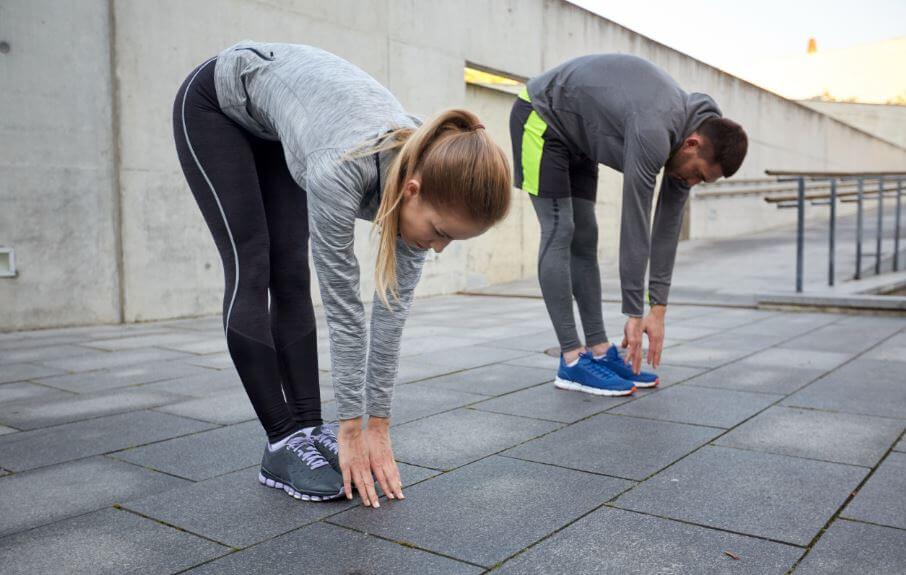4 Office Stretches to Relieve Tired Muscles

Taking a moment to complete “office stretches” (stretching at work) can give you the energy boost you need to keep going. Additionally, a good stretch will help your muscles, ligaments, and joints.
Working at an office might seem easy and comfortable. However, mental and physical exhaustion are common presences. In order to combat them, you need to look for ways to stay active and upbeat.
Lack of movement, an unfortunate modern reality
Sitting down in front of a computer or desk without doing any kind of physical activity makes you lethargic. It also increases the amounts or levels of cramps, tiredness, fatigue and other health or productivity problems.
As a response, you can try doing simple stretches to wake up your mind and body. These stretches will keep your muscles and brain oxygenated to help you finish all of your work tasks and stay healthy.
1. Stretch your back and arm muscles: great office stretches
This office stretch is great for your neck, spine, arms, and shoulders. It also stabilizes your posture while reducing any lower back pain. To get started, follow these steps:
- Sit down on the edge of your seat. Put your hands together and stretch out your arms towards the ceiling. Keep your back straight while looking forward. Slowly take a deep breath.
- Now, separate your hands and lower your arms, bending them as if to draw out a circle. Place your hands behind you and grip the back of your chair.
- After, stretch your arms and bring out your chest, arching your back. Hold this position for ten seconds.
2. Leg stretches
Maintaining good blood circulation is crucial, especially for those who sit in the same position for long periods of time.
Bending down or touching your feet will help your blood flow through your legs, preventing varicose veins, cellulite, cramps and muscle soreness. Doing so will also refresh your mind and regulate your heart rate. Stretch your legs by:
- Sitting: move your chair to an area that allows you to stretch your legs out completely. Keep your back straight and lean forward. Try to touch your toes. If you can’t reach that far, don’t worry, you’ll eventually work up to it. Don’t force your muscles to stretch more than they are able. The main point of stretching is to relax and lengthen muscle fibers so don’t take it too far.

- Standing: stand with your feet together and touch the tips of your toes. If you can’t reach, go into the table position by leaning forward while keeping your back straight.
3. Neck and shoulders: office stretches
Your neck and shoulders are areas that often build up stress and fatigue. Stretching them will help relieve tension and reduce discomfort.
To stretch your shoulders and neck, follow the steps below:
- Tilt your head backward, looking up towards the ceiling. After, bring it downwards. Move your head up and down around four times. Now, move your head from left to right. Then, move your head in a circular motion clockwise, and after, counterclockwise. Repeat this exercise around five times with breaks in between.

- Raise your shoulders as high as you can and hold the position for five seconds. Relax and move them backward in a circular motion. After repeat but this time, move them forwards instead.
4. Work out your leg muscles with lunges: office stretches
Working long hours sitting down has negative consequences for the body. Our bodies simply weren’t designed to spend most of the day in a chair. In light of that, doing some standing office stretches and using the muscles that lack movement can really come in handy. Try doing the following lunge:
- Stand with your hands on your hips and take a step forward, moving your weight to that leg. Bend your other leg, bring it down to the floor. Hold the position for ten seconds and repeat on the other side.

Office stretches are a great way to relieve tension and stay alert for your activities. You could even plan an hour to do some stretches, restarting your system and helping you to continue with your work.
Taking a moment to complete “office stretches” (stretching at work) can give you the energy boost you need to keep going. Additionally, a good stretch will help your muscles, ligaments, and joints.
Working at an office might seem easy and comfortable. However, mental and physical exhaustion are common presences. In order to combat them, you need to look for ways to stay active and upbeat.
Lack of movement, an unfortunate modern reality
Sitting down in front of a computer or desk without doing any kind of physical activity makes you lethargic. It also increases the amounts or levels of cramps, tiredness, fatigue and other health or productivity problems.
As a response, you can try doing simple stretches to wake up your mind and body. These stretches will keep your muscles and brain oxygenated to help you finish all of your work tasks and stay healthy.
1. Stretch your back and arm muscles: great office stretches
This office stretch is great for your neck, spine, arms, and shoulders. It also stabilizes your posture while reducing any lower back pain. To get started, follow these steps:
- Sit down on the edge of your seat. Put your hands together and stretch out your arms towards the ceiling. Keep your back straight while looking forward. Slowly take a deep breath.
- Now, separate your hands and lower your arms, bending them as if to draw out a circle. Place your hands behind you and grip the back of your chair.
- After, stretch your arms and bring out your chest, arching your back. Hold this position for ten seconds.
2. Leg stretches
Maintaining good blood circulation is crucial, especially for those who sit in the same position for long periods of time.
Bending down or touching your feet will help your blood flow through your legs, preventing varicose veins, cellulite, cramps and muscle soreness. Doing so will also refresh your mind and regulate your heart rate. Stretch your legs by:
- Sitting: move your chair to an area that allows you to stretch your legs out completely. Keep your back straight and lean forward. Try to touch your toes. If you can’t reach that far, don’t worry, you’ll eventually work up to it. Don’t force your muscles to stretch more than they are able. The main point of stretching is to relax and lengthen muscle fibers so don’t take it too far.

- Standing: stand with your feet together and touch the tips of your toes. If you can’t reach, go into the table position by leaning forward while keeping your back straight.
3. Neck and shoulders: office stretches
Your neck and shoulders are areas that often build up stress and fatigue. Stretching them will help relieve tension and reduce discomfort.
To stretch your shoulders and neck, follow the steps below:
- Tilt your head backward, looking up towards the ceiling. After, bring it downwards. Move your head up and down around four times. Now, move your head from left to right. Then, move your head in a circular motion clockwise, and after, counterclockwise. Repeat this exercise around five times with breaks in between.

- Raise your shoulders as high as you can and hold the position for five seconds. Relax and move them backward in a circular motion. After repeat but this time, move them forwards instead.
4. Work out your leg muscles with lunges: office stretches
Working long hours sitting down has negative consequences for the body. Our bodies simply weren’t designed to spend most of the day in a chair. In light of that, doing some standing office stretches and using the muscles that lack movement can really come in handy. Try doing the following lunge:
- Stand with your hands on your hips and take a step forward, moving your weight to that leg. Bend your other leg, bring it down to the floor. Hold the position for ten seconds and repeat on the other side.

Office stretches are a great way to relieve tension and stay alert for your activities. You could even plan an hour to do some stretches, restarting your system and helping you to continue with your work.
All cited sources were thoroughly reviewed by our team to ensure their quality, reliability, currency, and validity. The bibliography of this article was considered reliable and of academic or scientific accuracy.
- J., Y., H., K., K., W., & A., H. (2007). Stretching exercises vs manual therapy in treatment of chronic neck pain: A randomized, controlled cross-over trial. Journal of Rehabilitation Medicine, 39(2), 126–132. https://doi.org/10.2340/16501977-0015
- Henning, R. A., Jacques, P., Kissel, G. V., Sullivan, A. B., & Alteras-Webb, S. M. (1997). Frequent short rest breaks from computer work: Effects on productivity and well-being at two field sites. Ergonomics, 40(1), 78–91. https://doi.org/10.1080/001401397188396
This text is provided for informational purposes only and does not replace consultation with a professional. If in doubt, consult your specialist.








